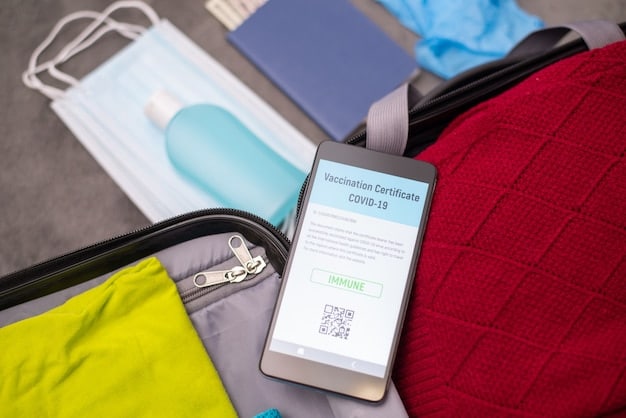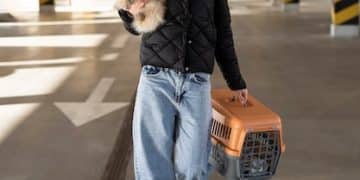New US Pet Travel Regulations: A Comprehensive Guide for 2024

Navigating air travel with your beloved pet in the US requires understanding the new regulations set by the Department of Transportation, including airline-specific policies, health requirements, and documentation, ensuring a safe and stress-free journey for both you and your furry companion.
Planning to fly with your pet within the US? Staying informed about the new US regulations for flying with pets is crucial for a smooth and stress-free travel experience. These regulations aim to ensure the safety and well-being of your furry companions while accommodating the needs of pet owners.
Understanding the Updated Pet Travel Guidelines
The landscape of pet air travel is continually evolving. Keeping abreast of the latest changes ensures compliance and contributes to a better travel experience for all involved.
Recent updates to pet travel regulations in the US encompass several key areas, from updated carrier standards to revised health documentation requirements. The Department of Transportation (DOT) alongside airline-specific policies, dictates the framework for these changes, which are primarily aimed at enhancing pet safety during transit.
Key Changes in Pet Travel Policies
Airlines have been gradually updating their policies regarding pet travel. These changes come as a response to greater awareness of animal welfare, focusing on the importance of proper handling. It’s critical to check with the airline directly, as policies can vary significantly.
These updates may include restrictions on breeds or sizes of animals allowed to fly, and specific crate guidelines, and temperature restrictions.
- Breed Restrictions: Certain breeds, particularly brachycephalic (short-nosed) breeds like Bulldogs and Persian cats, may face restrictions due to respiratory issues.
- Size and Weight Limits: Airlines may have limits on the size and weight of both the pet and its carrier, impacting whether your pet can travel in the cabin or as cargo.
- Crate Requirements: Crates must meet specific size and ventilation standards to ensure the animal’s safety and comfort.
Understanding these changes is the first step in preparing for your trip. Always confirm the latest requirements with your airline well in advance of your travel date to avoid potential complications.

Ensuring Your Pet Meets All Health Requirements
Prioritizing the health and well-being of your pet is essential when planning to fly. Beyond airline regulations, there are strict federal and state health requirements to consider.
Meeting the health requirements for pet air travel involves several steps, beginning with consulting your veterinarian. Federal guidelines mandate that pets are healthy enough to fly, and this must be certified by a licensed vet.
Essential Veterinary Checks and Vaccinations
Before your trip, schedule a thorough check-up with your veterinarian. Vaccinations are a key part of this process, especially for diseases like rabies, distemper, and parvovirus. These not only protect your pet but also comply with health regulations at your destination.
Your veterinarian can provide a health certificate, which is a document required by most airlines and some states. This certificate verifies that your pet is free from infectious diseases and is fit to travel.
- Health Certificate: Must be issued within 10 days of travel.
- Vaccination Records: Ensure all vaccinations are up-to-date.
- Parasite Treatment: Protection against fleas, ticks, and heartworms.
These steps are crucial to ensure that your pet is healthy enough to endure the journey and meets all the necessary legal requirements.
Navigating Airline-Specific Pet Policies
Beyond the overarching federal guidelines, each airline establishes its own protocols for pet transportation. Understanding these airline-specific policies is critical for planning your pet’s journey.
When flying with your pet, policies can vary significantly depending on the airline. These differences can cover booking procedures, fees, and the types of pets allowed, etc. It’s essential to research and understand these details early in your travel planning process.
Comparing Pet Policies Across Major US Airlines
Each airline has a unique set of rules regarding pet travel, including restrictions on breed and size, as well as travel fees. Familiarizing yourself with these specifics helps avoid any surprises at the airport.
Airlines like United, American, and Delta all permit pets under certain conditions, but their rules about breeds, carrier sizes, and fees will vary. Checking these policies early in the planning process ensures your pet can travel safely with you.
- Cabin vs. Cargo: Determine if your pet can travel in the cabin or if it must go in the cargo hold.
- Breed and Size Restrictions: Check specific breed prohibitions and size limitations that might affect your pet’s travel eligibility.
- Fees and Reservations: Understand the pet fees and book your pet’s spot well in advance, as space is often limited.
By comparing these policies, you can make an informed decision about which airline best suits your and your pet’s needs.

Choosing the Right Carrier for Your Pet
A comfortable and secure travel carrier is crucial for your pet’s safety and comfort during a flight. The right carrier can significantly reduce stress for both you and your animal.
Selecting the right carrier involves considering factors like size, ventilation, and material. The goal is to provide a safe and stress-free environment for your pet during the flight.
Key Features of a Safe Pet Carrier
A well-suited pet carrier should meet several criteria: It must be large enough for your pet to stand, turn around, and lie down comfortably. Additionally, good ventilation is essential and the material should be sturdy enough to withstand travel handling.
For in-cabin travel, carriers must fit under the seat in front of you. For pets traveling as cargo, the carrier needs to be extra sturdy and well-ventilated.
- Size Appropriateness: Ensure your pet has adequate space to move comfortably.
- Ventilation: Look for carriers with sufficient ventilation on all sides.
- Durability: Opt for carriers made of sturdy, non-toxic materials.
Choosing a carrier that meets these standards will help ensure a safer and more comfortable journey for your pet.
Preparing Your Pet for Air Travel
Preparing your pet for air travel is a process that requires patience and planning. Gradually introducing them to the travel carrier and getting them used to the sounds and sensations of travel can help reduce anxiety.
Ahead of your travel date, start acclimatizing your pet to its carrier. Make the carrier a positive space. Use positive reinforcement to associate the carrier with comfort and safety.
Acclimation Techniques and Comfort Measures
Start by placing the carrier in a frequently used room and encourage your pet to enter it with treats and toys. This helps them associate the space with positive experiences, making them more comfortable.
Consider using calming aids recommended by your vet if your pet is particularly anxious. These could include pheromone sprays or calming treats.
- Familiarize with Carrier: Start early so your pet adjusts to their travel space.
- Calming Aids: Consider calming products to ease anxiety.
- Travel Simulation: Simulate travel by taking short car rides.
Preparing your pet adequately can greatly diminish travel-related anxiety.
Understanding Quarantine Regulations and Restrictions
Different states and countries have varying quarantine regulations in place to prevent the spread of diseases. It’s critical to be aware of these rules, especially if your travel plans involve international destinations.
Quarantine restrictions are enforced to safeguard public health and prevent the introduction of foreign diseases. These regulations vary significantly by location, so it’s important to check the requirements for your destination.
Navigating State and International Quarantine Rules
Each state has the right to impose its own quarantine rules for animals entering its borders. Some states may require longer quarantine periods or specific vaccinations.
Internationally, regulations can be even more complex, often requiring permits, additional health checks, and longer quarantine times upon arrival.
- State Guidelines: Check destination-specific requirements well in advance.
- International Rules: Obtain necessary permits and meet health standards.
- Quarantine Lengths: Be prepared for mandatory quarantine periods that can range from a few days to several months.
Understanding and preparing for these quarantine requirements can greatly facilitate your pet’s entry into the new location.
| Key Point | Brief Description |
|---|---|
| ✈️ Airline Policies | Each airline has specific rules that must be followed closely. |
| 👩⚕️ Health Requirements | Veterinary checks and vaccinations are essential for your pet’s travel. |
| 🧳 Carrier Choice | Select an appropriate and safe carrier for comfortable travel. |
| ⏳ Preparation | Acclimate your pet for a stress-free travel experience. |
Frequently Asked Questions (FAQ)
▼
Typically, you’ll need a health certificate from a vet issued within 10 days of travel, vaccination records, and any specific forms required by your airline. Ensure all documents are up-to-date.
▼
No, some breeds, especially brachycephalic (short-nosed) breeds like Bulldogs and Persian cats, may be restricted due to respiratory issues during flight. Check with the specific airline.
▼
Acclimate your pet to their carrier weeks before the flight, use calming aids if recommended by your vet, and ensure they have access to water. A familiar blanket can also help.
▼
In the cabin, pets must typically fit in a carrier under the seat. In cargo, carriers must meet specific ventilation and size standards. Cargo travel may also have temperature restrictions.
▼
Yes, airlines typically charge a fee for pets, whether traveling in the cabin or as cargo. These fees vary by airline and are usually charged per flight segment, so budget accordingly.
Conclusion
Understanding and adhering to the new US regulations for flying with pets ensures that your travel is safe, compliant, and stress-free for both you and your animal. Preparation, adherence to airline-specific policies, and attention to your pet’s health needs are key to a successful journey.





